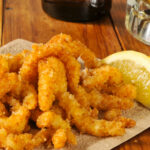National Eat Beans Day (or National Eat Your Beans Day) occurs on July 3 each year, and we guarantee it will be a holiday that will give you a whole new appreciation for legumes as a food group. And if not, perhaps our fun facts and riddles will have you full of beans. Try this one on for size — ‘I am a bean, very lean. I am not fat, I’m sure of that. Like all beans, I’m small and round — but unlike others, I don’t grow in the ground’. Giving away the answer would be too easy, but we’ll give you a hint — this may be a kid’s favorite kind of bean. It may also surprise you to know that beans are not strictly classified as ‘veggies’ either since legumes by definition are any seeds or fruits that grow within pods or the edible pods themselves, which grow on leguminous plants (i.e. those belonging to the pea family). This opens up a whole world of beans to us, which should be exciting, especially for those who grew up being forced to eat beans as a vegetable.
History of National Eat Your Beans Day
Though the exact date and reason for National Eat Your Beans Day being made a holiday are not known, we do know that the history of the bean itself predates even the invention of the pots used to cook beans. Bean cultivation dates back as early as 7,000 years ago, making it a staple that has stood the test of time, and we’re not surprised. With amazing health benefits, legumes are plant-based, protein-packed powerhouses of nutrition. So this also means that they’re for everyone, no matter the diet or lifestyle choice. It’s very rare to find a person allergic to beans too, though some legumes can trigger allergic reactions, such as peanuts.
Beans are originally from wild vines which grow in Central and South America. This is known as the common bean, and since then, thousands of bean varieties exist today and are cultivated all over the world. They are one of the most versatile crops and can be grown almost anywhere. 5,000 years ago the lima bean and other varieties were a popular favorite among the Incas and Aztecs, and the popularity of beans is so much so that they are worth a mention in Homer’s “Iliad,” where he uses beans as a metaphor. Ancient Egyptians seem to have also been partial to beans and lentils, as paintings and physical evidence shows that bodies were buried with beans, to nourish them on their journey to the afterlife. By the 1500s, with the advent of trade via ships, beans began to reach all the corners of the globe and more varieties began to be cultivated. Though often viewed as a poor man’s food, beans have been an important source of nourishment for people in dire circumstances; such as the soldiers who fought in the First and Second World Wars, or the Europeans who were dying out due to the spread of the plague in Europe, during the Middle Ages. Who would have thought beans could be such lifesavers.
National Eat Your Beans Day timeline
The French begin to add chickpeas to their vegetable soup, making it a heartier meal in every way.
Emperor Charlemagne orders the cultivation of chickpeas to save people from the ravage of war, and it works.
With the increase in trade, beans begin to be traded all over the world.
Beans become the poor man’s meat during the Great Depression in America, enabling many families to survive.
National Eat Your Beans Day FAQs
What are the healthiest beans to eat?
The top nine healthiest beans/legumes to eat are — chickpeas, lentils, peas, kidney beans, black beans, soybeans, pinto beans, navy beans, and peanuts.
Is it bad to eat beans at night?
Yes, eating beans at night is not recommended. This is because beans can cause indigestion or gas problems, so it’s better to stick to eating that bowl of chili during the daytime.
Is it okay to eat beans every day?
Yes! Not only are beans low in fat, but they are also great sources of protein and fiber, and they come packed with nutrients like iron, folate, calcium, and potassium. This can help protect against high cholesterol which may lead to heart disease. The recommended portion size of beans/lentils is 25-38 grams a day.
National Eat Your Beans Day Activities
Eat beans
Yes, you guessed it. Sometimes simplicity is everything. In this case, we’re keeping it real simple, by telling you to go eat some beans — green, black, red, or yellow — the choice is yours. Boil them, bake them, saute them, mush them, or eat them raw; beans are bound to have your body thanking you for years to come.
Grow your own beanstalk
Though we cannot guarantee a hen laying golden eggs at the end of it, we can guarantee that there’s nothing better than the feeling of eating your own home-grown produce. And what’s more, the golden glow of health which your beans will bring you is worth far more than any golden egg-laying hen!
Fix up a care package
One of the things we love about beans is how affordable (we daresay cheap even) they are. So why not take the time to gather some different types of legumes, a hand-written little booklet of recipes, and give them to a family who may need extra beans.
5 Recipes We Bet You Never Thought Used Beans
Beanie brownies
These ooey-gooey delicious brownies come with a surprising twist — black beans are the star ingredient!
Honey-roasted chickpeas
Step aside, caramel popcorn, as this delicious, crunchy snack takes over the coffee table at your next movie night.
Navy bean pesto
Pureed navy beans with any greens can make an amazing and hearty pesto sauce.
Bean burger
All the flavor, all the protein, but not meat. Perfect for everyone, even those hardcore meat lovers.
Alfredo sauce
White beans can make the perfect, silky alfredo sauce, which will cause all to go “mama mia”!
Why We Love National Eat Your Beans Day
Beans are healthy
If we have not said this enough times already, we will say it again — beans are so good for you. Not only are they amazing sources of protein and fiber, but they also contain folic acid, iron, potassium, and calcium, all of which are beneficial to prevent all sorts of medical conditions.
Beans have a variety
Some say that there are as many as 4,000 varieties of beans out there. If that doesn’t inspire you to start exploring and experimenting in the kitchen, we don’t know what will. Trying out different beans can also bring you one step closer to exploring a whole new cuisine or culture, and variety is the spice of life, after all.
Beans are cheap
We’re glad that beans were overlooked by the rich snobs throughout history so that we all can enjoy the delicious benefits of beans without feeling the pinch in our pockets. For something to be cheap and nutritious almost stretches belief.
National Eat Your Beans Day dates
| Year | Date | Day |
|---|---|---|
| 2025 | July 3 | Thursday |
| 2026 | July 3 | Friday |
| 2027 | July 3 | Saturday |
| 2028 | July 3 | Monday |
| 2029 | July 3 | Tuesday |




















